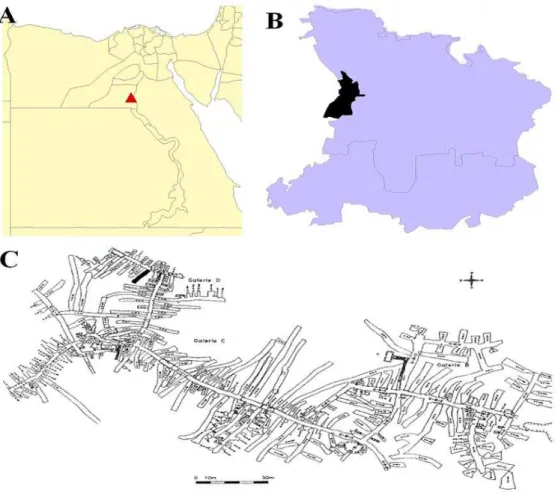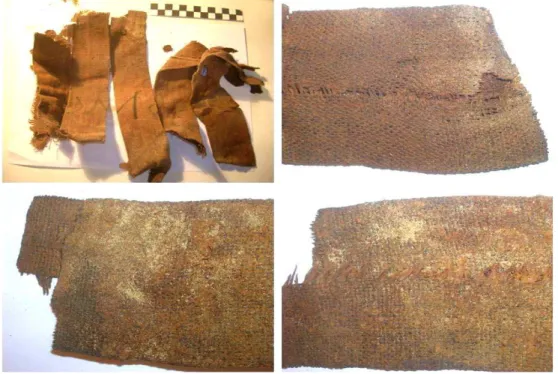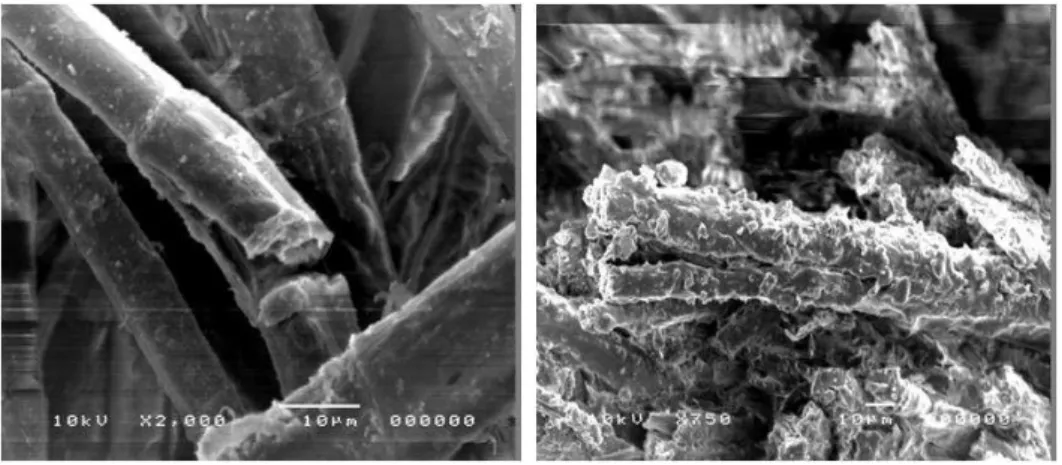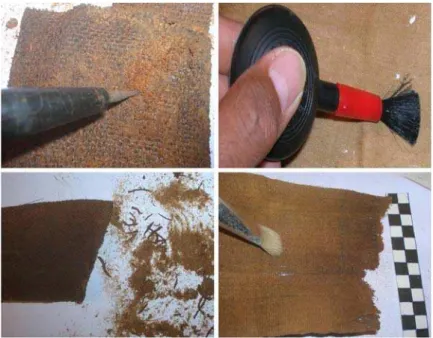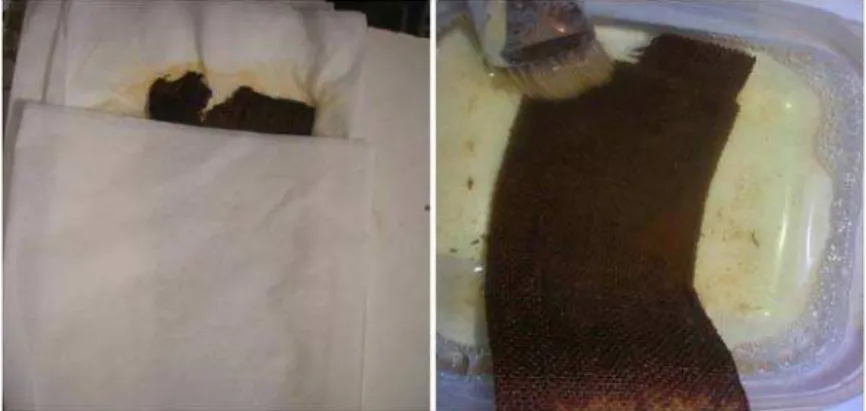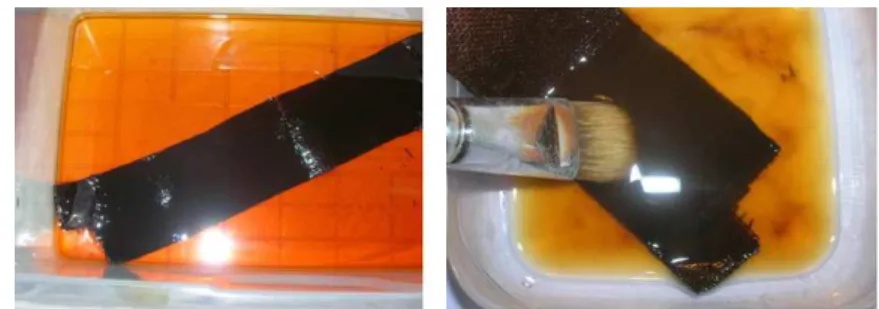ISSN: 2067-533X
INTERNATIONAL JOURNAL
OF
CONSERVATION SCIENCE
Volume 2, Issue 3, July-September 2011: 155-164 www.ijcs.uaic.ro
STRATEGY FOR PRESERVATION OF PTOLEMAIC WRAPPED
MUMMY’S LINEN IN TUNA EL-GEBEL EXCAVATION, EGYPT.
A CASE STUDY
Harby E. AHMED *
Conservation Department, Faculty of Archeology, Cairo University, Egypt
Abstract
This research shows the practical strategies which were chosen for maintenance and conservation of textiles discovered in Tuna el -Gebel excavations, Egypt. This process represents the first aid to these objects, hidden in tombs over thousands of years. Thus, the operations carried out are very important in detecting the state of conservation of these remains of human activity. They also aimed at reducing the damage caused by storage conditions through thousands of years. The challenge that conservators of historic textiles face in this case is the decrease of the available and necessary possibilities for conducting the process of restoration in the best way. On the other hand, leaving these textiles without a conservation process may double the causes of damage in the textiles leading eventually to their complete loss.. The process of restoration has been recorded step by step, from the historical records of textiles to the cleaning processes. Moreover, the choice of a new holder for displaying textile pieces in museum and their placement in it are discussed.
Keywords: Linen textile; Excavation; Conservation; Mummies; Cleaning; Support; Black ink.
Introduction
Textiles are part of our daily life now as much as in the past, from very early with human activities have been concentrated on the making of cloth and embellishing it for the purpose of keeping as warm and comfortable as possible, to show status- emperor, soldier, beggar man, thief- and to identify oneself. Many cultures of this world are still identified by their beautiful costume and textiles [1, 2].
Textile fibers and weaves are very sensitive to environment; for this reason such archaeological findings are rare and subordinate to several conditions which can lessen the amount and the rate of damage [3]. They are extremely vulnerable to damage when stored or displayed in inappropriate environmental conditions [4]. Conservation aims to slow down the rate of the further deterioration of textile artifacts as much as possible. Conservation processes include cleaning disinfection, consolidation, display and storage processes. Any material that is suggested for cleaning should be tested and laboratory evaluated before any cleaning treatment is undertaken [1, 5-7].
*
The ibiotapheion (ibis burial place) at Tuna El-Gebel, located in the west of the ancient city of Thermopolis Magna, has been the first and for a longer period the only ibis (and baboon) animal cemetery during the reign of Pharaoh Psametikhos (664-619 BC). The total number of ibises deposited in the vast subterranean network of galleries clearly surpasses one million individuals, implying that on average some 15000 birds had been placed each year in the galleries by the cult servants. These include domestic (cattle, sheep, dogs, cats) and wild mammals (shrews, monkeys, ichneumons, wild cats, gazelles etc), reptiles (crocodiles, snakes) and fish, as well as a large variety of birds (herons, storks, geese, ducks, birds of prey, owls etc). Today the archaeological area of Tuna El Gebel is located in a flat desert landscape, west of the cultivated Nile valley, 5km from the modern village, opposite a broad desert wadi(valley), through which a track once led to the Bahariya oases (Fig.1) [8].
Fig. 1. General map of Egypt: A - Tuna el-Gebel in Middle Egypt (red triangle); B – Detailed map of Tuna el-Gebel (black color) and C) The plan of the galleries: subterranean animal necropolis at Tuna el-Gebel, Middle Egypt (entire scale = 50m)
Description and Conditions
The excavated textile objects consist of four pieces of linen scrolls (Fig. 2) used for wrapping mummies. They date back to the Ptolemaic period (330 BC: 30 AD) as there are writings in ancient Greek language written in black ink. The writings may refer to the name of the dead and serves as evidence that this is an external layer of wrap. The number of registry is 5314 and they have been found in the excavations of "Tuna El-Gebel" on 27/03/2004. The registry does not give information about the exact place of discovery and nothing is known about the textiles’ condition when they were found. The textile structure of the pieces is plain 1/1. Plain weave is the simplest of all weaves. It has one-over one-under interlacing for both warp and filling yarns. Warp yarns are 14 and yarns of weft are 9 by square centimeter. The pieces are in a severe dry state so that they can be easily broken. They show many types of damage including calcified sand and mud soiling that adhered to them. In addition to their weakness, separated parts, fragility, soiling and dark brown spots which could be the result of resin used to isolate mummies from the surrounding air humidity occurred. The pieces’ sizes are: 15.5 × 4.5 cm, 19.5 × 4.7 cm, 27 x 5.5 cm, 25 × 5.5 cm, 25 × 5 cm.
Fig. 2. The textile objects after excavation (before conservation - the pieces contain many marks of damage including calcified sand and mud soiling and stuck by the pieces)
location. In general, the objects suffered from intensive surface damage which resulted in fiber deformation, missing parts and holes especially along the objects edges. The terminal fringes of the objects were weak because of abrasive damage and tearing.
Examination Method
Morphological study
The morphology of the surface of the wrapped linen was investigated using Scanning Electron Microscope (SEM) - a Quanta 200 ESEM FEG from FEI. Small samples were taken and investigated under SEM, to show the quality of the fibers as well as their damage aspects [9, 10].SEM pictures of examined warped mummy’s linen are illustrated in Figure 3 showing the linen fibers identified from different parts of the object. The fibers are extremely roughened, damaged, broken with transverse cracking and longitudinal splitting characterized by small scratches, small slits and holes. Furthermore, one can see the dust, dirt that covered the fiber.
Fig. 3. SEM images that show some deterioration and degradation aspects in fibers
Dyes stability test
The yarn direction spun and woven structure with the condition of the specimen before the dye testing was recorded. It is first tested with a drop of water and then a few drops of detergent solution (Synperonic N); I propose to use on the specimen. It was found that the dyes were stable and did not bleed with the wet cleaning solution [11, 12].
Treatment procedure
Wetting process
Due to the severe dry conditions of the pieces which lead to the difficulty of holding them, therefore wetting processes have been conducted by using the water spray. This process has been repeated three times over different periods of times in an attempt to restore some flexibility to these pieces. This process is simple and successful to a great extent and it makes the researcher able to conduct the restoring process [11, 13].
Cleaning procedure
a. Mechanical cleaning
with air blower in addition to using tools with tapered part for breaking up the calcified sands and removing them easily by the different brushes, as shown in Figure 4. Despite its simplicity, it is very effective to remove a great percentage of sand and dirt [14], as shown in Figure 5.
Fig. 4. Mechanical cleaning method applied on the textile objects
b. Wet cleaning
The washing solution to be used is prepared in a separate vessel in order not to cause the textile to be moved out of the washing tray each time the solution is changed. I used a pH indicator paper in a plastic container. The choice of detergent is determined by the fiber and soil present in the fabric. Unless there is a possibility of damage, the textile is allowed to soak in the detergent solution for a period of time (15mintes). In some cases, soil removal has been aided immensely without mechanical action. During these periods, enough solution is used to cover or submerge the specimen [9].
This cleaning procedure used water with other detergent agents (Synperonic N), to increase the effectiveness of the cleaning process. The ratio was one part detergent Synperonic N to 100 parts of distilled water. The water was agitated by the hand to allow it to penetrate between the fibers to release the dirt particles, for 15 minutes. The bath temperature was 30ºC in order to increase the effectiveness of cleaning. Then a second cleaning bath with distilled water only was applied by the conservator for 10 minutes again with water agitation and then a third bath with distilled water only, for 10 minutes. It also reduced the soiling, relaxed the fibers, removed the creasing and brightened the colors [3, 15, 16], as shown in Figure 6.
Fig. 6. Wet cleaning procedure
c. Dry cleaning
Fig. 7. Dry cleaning procedure
Removing the water from the textiles
Acid free paper (Japanese paper) is laid directly onto the surface of the textile and again pressed carefully with the hands. Always keep in mind that the textile at this stage is still soft due to its wet state and can easily be damaged during this handling, so a great deal of care must be exercised. A table is prepared and sheets of black plastic, used in bags of rubbish collection, are set. Then the wetting textile pieces after the process of wet cleaning are put over the table. The sheets of Japanese paper are set over the pieces for absorbing the water from the textiles.
The final support process
Preparing textile holder
A support from plywood was used. The plywood in its dimension is 5 cm larger than the dimensions of the textiles. Its surface is cleaned by using pure ethanol (C2H5OH) to remove any element of dust or biological infections which may exist on the surface of wood. After that, the wood is isolated by using Paraloid B-72 (an ethyl methacrylate/methyl acrylate copolymer) with concentration of 20% for isolating and protecting the wood holder from the effect of the relative humidity during the stage of storage or when they are displayed in the museum. One side of wood is covered by non- woven cloth (the first layer) to give a flexible surface and decrease the effect of the solidity of wood holder on the antiquities. The cloth in its dimension is 2 cm larger than that of the plywood holder from each side. The new linen fabric (the second layer) is fixed on the plywood by fixing the over plus from the edges by using the method of sticking with using Paraloid B-72 with concentration of 40%. The second stage is preparing a textile holder from 100% raw linen cloth as it is washed well to get rid of the remnants of industry material and get rid of its shrink of size when it is exposed to moisture or lose it. The linen is ironed by a hot iron to get rid of the wrinkles of the surface of cloth. The holder becomes ready to fix the antiquities on it [18,19], as shown in Figure 8.
Fixing the object
Fig. 8. The preparation of the support from plywood.
Conclusions
This study shows that the object dates back to the Ptolemaic period as there are writings of the ancient Greek language written in black ink. The Wrapped Mummies are composed of linen fibers and the textile structure of the pieces is plain 1/1. The appearance of the Wrapped Mummy’s Linen objects- after all treatments- shows that there is an improvement in the integrity of the objects. The Wrapped Mummy’s Linen is aesthetically pleasing and are free from dirt and damage.
Wet cleaning alone does not dissolve oils, resin but may be emulsify fresh oils and waxes with the help of soaps and detergents. Removal of oil dirt and resin depends on soaking techniques rather than agitation. For soaking in a dry cleaning system, the author has had good results by immersing fragile textiles in the solvent which is circulated through the bath. Dark brown dirt, perhaps it is resin that had been used in mummification, it is still unknown, so we need investigation in order to identify this kind of resin.
This research shows the practical strategies which have to be followed in maintaining and conserving textiles discovered in Egyptian excavations. Furthermore, it encourages the improvements of the physical and environmental conditions in which textiles are kept to optimize their long-term chances of survival in storage or display place.
Acknowledgements
The author would like to thank Dr. Mahmoud Eibed, College of Archeology, Cairo University, Egypt. Furthermore, Katrin Schlueter and Melanie Flossmann from the Ludwig Maximilian University, Institute for Egyptology, Munich, German for their contributions. This research is a part of works of Joint- mission Cairo -Munch (Tuna el -Gabal Excavation, Egypt).
References
[1] A. Balázsy, D. Eastop, Chemical principles of textile conservation, Butterworth- Heinemann, Oxford, UK, 1998, pp. 284 -287.
[2] H. Ahmed, Treatment and conservation of textile with written decoration applied to some chosen samples from the textile of the Ottoman Age, M.A. Thesis. Cairo Univ., Egypt, 2002.
[3] S. Landi, The textile Conservator’s Manual (Second edition), Butterworth - Heinemann, London, 1992, pp 80-87.
[4] M. Fahey, The Care and Preservation of Antique Textiles and Costumes The Henry Ford, (2007), in: http://www.thehenryford.org/explore/artifacts/textile.asp#1.
[5] D. Eastop, and M. Brooks, To Clean or Not to Clean: The Value of Soils and Creases,
Preprints of the 11th Triennial Meeting of the ICOM Committee for Conservation, Edinburgh, 1996, pp. 687- 691.
[6] Y. Shashoua, Investigation into the Effects of Cleaning Old, Dyed, Naturally Soiled Textiles
By Aqueous Immersion, Preprints of the 11th Triennial Meeting of the ICOM
Committee for Conservation, Edinburgh, 1996, pp.714 -720.
[7] Y. Shashoua, Investigation into the effects of cleaning natural woven textiles by aqueous
immersion, ICOM preprint 19th Triennial Meeting, Dresden, Germany, 1990, pp.
315-319.
and the Levant, International Journal for Egyptian Archaeology and Related Disciplines, XV, 2005, pp. 203-244.
[9] J. Columbus, Washing Techniques Used at the Textile Museum, Bulletin of the American Group, International Institute for Conservation of Historic and Artistic Works, 7, 1967, pp 14-16.
[10] J. Batcheller, Optical and scanning electron microscopy techniques for the identification of
hair fibers from Romano- Egyptian textiles Scientific Analysis of Ancient and Historic
Textiles: Informing Preservation, Display and Interpretation (Eds: R. Janaway, P. Wyeth), AHRC Research Center for Textile Conservation and Textile Studies, First Annual Conference, 13-15 July 2004, UK, pp. 51-57.
[11] O. Brigitte, Fastness to Light and Washing of Direct Dyes for Cellulosic Textile, Studies in Conservation, 41, 1982, pp. 129-131.
[12] F. Lemberg, Textile Conservation and Research, Abegg-Stiftung, Bern, 1988, p. 128. [13] E. Wilson, Color Conservation problems of a Twentieth Century Historic Dress,
Preservation of Paper and Textile of Historic and Artistic, 2, 1981, pp. 13-23.
[14] G. Nicola, The Examination and Conservation of Tow Indian Textile, The Conservator, 17, 1993, pp. 102–111.
[15] S. Haward, An Introduction of the Wet Cleaning of Carpets, The International Perspective on Textile Conservation Report ICOM, Amsterdam, 1994, pp. 21:29. [16] Y. Moes, Tapestry Cleaning by Aerosol Suction, The International Perspective on
Textile Conservation Report ICOM, Amsterdam, 1994, pp. 46-51.
[17] J. Rice, Dry cleaning versus wet cleaning for Treating Textile Artifacts, Bulletin of the American Group. International Institute for Conservation of Historic and Artistic Works, 12, 1972, pp, 50-55.
[18] S. Fletcher, J. Walsh, The treatment of three prints by whistler on fine Japanese, Journal of American Institute for Conservation, 18, 1979, pp 119- 126.
[19] V. Constance, The Conservation of Tapestries for Museum Display, Studies in Conservation. 15, 1970, pp. 134-153.
[20] F. Greene, The Cleaning and Mounting of a Large Wool Tapestry, Studies in Conservation, 2, 1955, pp. 1-16.
